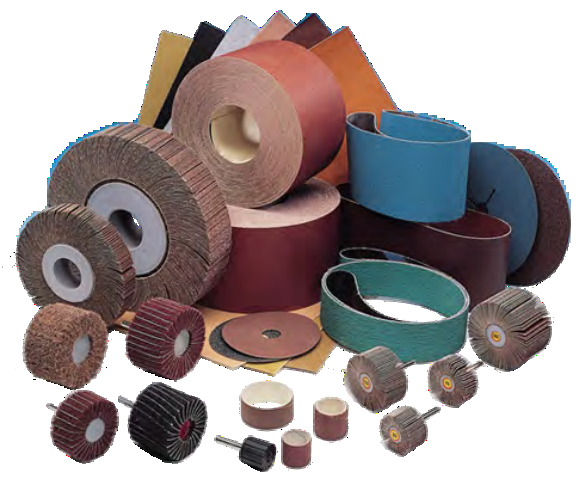- What Are The Main Types Of Coated Abrasive Products?
Coated abrasives are abrasives made of substrate, binder, and abrasive. Has good flexibility and adaptability. It is divided into manual use, semi-manual use and machine use. Manual products mainly include sheet-type dry sanding cloth, dry sandpaper, and water sandpaper that we see daily. Most of the semi-manual products are special-shaped products, including page wheels, chuck page wheels, and handle page wheels. , all kinds of grinding discs. Machine products are mainly all kinds of abrasive belts, which can grind planes, elevations, curved surfaces and even various shapes of work objects.
- What Is The Process For The Manufacturing Of Coated Abrasive Products?
- Printing of backing
- Make Coat Application
- Grain Application
- Drying/Curing
- Size Coat Application
- Final Drying and Curing
- Winding of Rolls
- Final Production
- How To Differentiate Open-Coat And Closed-Coat Abrasive Products?
Coated abrasives are generally manufactured in two levels of abrasive grain surface density. Closed-Coat The abrasive grains completely cover the coated surface of the sandpaper backing. The greater number of abrading points per square inch causes faster stock removal during use and produces a better finish than open-coat. Closed-coat is recommended where loading is not a significant problem. Open-Coat The abrasive grains cover approximately 50% to 70% of the coated surface of the backing. Open-coat abrasives are the best choice where clogging or filling of the abrasive surface would otherwise be a problem. They offer greater flexibility, but are harsher cutting and do not provide as good a finish as closed-coat. Wood, soft metals and fiberglass sanding are typical applications for open-coat products. Binic offer best sanding discs for paint removal.
- How Many Types Of Adhesives Are Used In Manufacturing Coated Abrasives?
Coated abrasives use one of two types of adhesives. One is based on animal glue and the other is based on synthetic, heat-hardenable resins. The adhesive is applied with a minimum of two bonding applications. The first or “maker” coat adheres the abrasive grain to the backing, ensuring proper anchoring and orientation. After drying or curing, the second or “sizer” coat is applied. The sizer adhesive unites with the maker bond to provide final grain anchoring and proper total-adhesive level for the finished product. Glue Bond Glue has a tendency to soften from the normal heat of grinding.
Glue bond products usually produce a more uniform, less harsh finish which, in the case of fine grits, can be easily buffed out. Resin Bond Resins offer greater heat resistance and are more durable in heavy stock removal operations. Resin bond products are the best all-around coated abrasives. However, they have a tendency to produce a harsher, more scratchy finish which, in the case of finer grits, is more difficult to buff out.
Conclusion
Above all, coated abrasives are used in a wide variety of applications, including metal, wood sanding, leather, glass, building materials, plastics, and ceramics. Can be used for dry or wet grinding. In recent years, its scope of use has penetrated into many aspects of people’s lives, and it has become the most widely used type of abrasive tool.



